A Megastar Of World Cruising
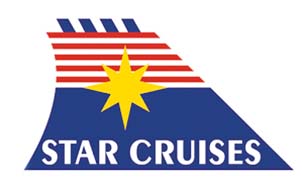 Star Cruises has become the third biggest cruise line in the world in just twenty one years after a new start up in 1993 offering Far East based cruises. The takeover in 2000 of the long established Norwegian Cruise Line (NCL), formed in 1968 as Norwegian Caribbean Lines, expanded the cruise portfolio to worldwide cruising. When these two cruise lines are taken together, they currently operate twenty two big cruise ships cruising worldwide. Carnival Cruise Lines occupies the top position in the world in terms of number of cruising berths, with Royal Caribbean International in second position.
Star Cruises has become the third biggest cruise line in the world in just twenty one years after a new start up in 1993 offering Far East based cruises. The takeover in 2000 of the long established Norwegian Cruise Line (NCL), formed in 1968 as Norwegian Caribbean Lines, expanded the cruise portfolio to worldwide cruising. When these two cruise lines are taken together, they currently operate twenty two big cruise ships cruising worldwide. Carnival Cruise Lines occupies the top position in the world in terms of number of cruising berths, with Royal Caribbean International in second position.

Star Cruises was founded on 10th November 1993 as an associate of the powerful Malaysian Genting International Group with many hotels and luxury resorts in its portfolio. The aim was to dominate the fast growing Asian cruise market from Singapore and Hong Kong, particularly up the west coast of Malaysia to Langkawi in Malaysia and Phuket (pronounced ‘pooket’) in Thailand. In April, 1995, Star Cruises launched a HK$32 million promotion campaign to raise its profile and clarify the three types of cruising experience it offered. Chief Executive Eddy Lee had masterminded this advertising campaign for these three types of cruising:-
STAR cruising experience, comprising two big cruise liners, Langkapuri Star Aquarius based in Singapore and Star Pisces based in Hong Kong, to appeal to first time cruisers. Langkapuri Star Aquarius was named after the Langkapuri Beach Resort at Cenang Beach on Langkawi Island, whose capital is Kuah and is the largest of one hundred islands in the archipelago. She offered three day cruises from Singapore to Langkawi and Phuket all year round. Star Pisces offered three day cruises from Hong Kong to Shanghai and Japan all year round. They were purchased from Viking Line as the passenger car ferries Athena and Kalypso and converted with full cruising public rooms and facilities. They featured large duty free shopping centres and supermarkets, two casinos with one having a finely detailed ceiling and red décor, seven restaurants, and a top rated health club for men with gymnasium, swimming pool, whirlpool, massage and sauna. Star Pisces has a Chinese restaurant serving Cantonese and Sichuan food, and a Japanese restaurant serving sushi seafood.
SUPERSTAR cruising experience, comprising the medium sized cruise liner Superstar Gemini, to appeal to traditional ‘western’ cruise passengers from America and Europe who wanted high class service and multiple destinations. She offered five day cruises to and from South East Asian ports including Singapore, Bangkok, Beijing, Bangkok and Japanese ports all year round. She had been built at Valencia by Union Naval de Levante as Crown Jewel in 1992 and had a sister in Cunard Dynasty, and featured a five deck glass walled atrium.
MEGASTAR cruising experience, comprising two much smaller yacht like cruise ships, Megastar Taurus and Megastar Aries, to appeal to sophisticated, rich cruisers who wanted the opulence and atmosphere of private yachts. The two yacht like cruise ships had berths for only 82 passengers in 33 cabins and were served by 59 crew members. They offered seven day luxury cruises to and from South East Asian ports all year round. They featured Asian and international cuisine, good use of wood in the public rooms, and with a private club ambiance and sophisticated décor.
The advertising campaign certainly worked, as by the end of 1995 one half of a million Asians had taken a cruise, with 50% of clients Singaporeans, 30% of clients Malaysians, and 20% of clients coming from other Asian countries. The marketing campaign was aimed at airline and hotel reservation systems and new internet systems, and thus tended to attract a younger profile of clients. Star Cruises had offices at the end of 1995 in Singapore, Hong Kong, Kuala Lumpur, Penang, Thailand, Taiwan, Japan and Jakarta in Indonesia. The company won the World Travel Market Global Award for 1995 for promoting Asian holidays. International cruise passengers began to be attracted from Australia and New Zealand, and their dark blue hulls and colourful funnel colours were beginning to be noticed in brochures in the United States. The funnel colours are blue on the lower half and red and white horizontal stripes at the top, with a golden yellow star in the middle of the funnel.
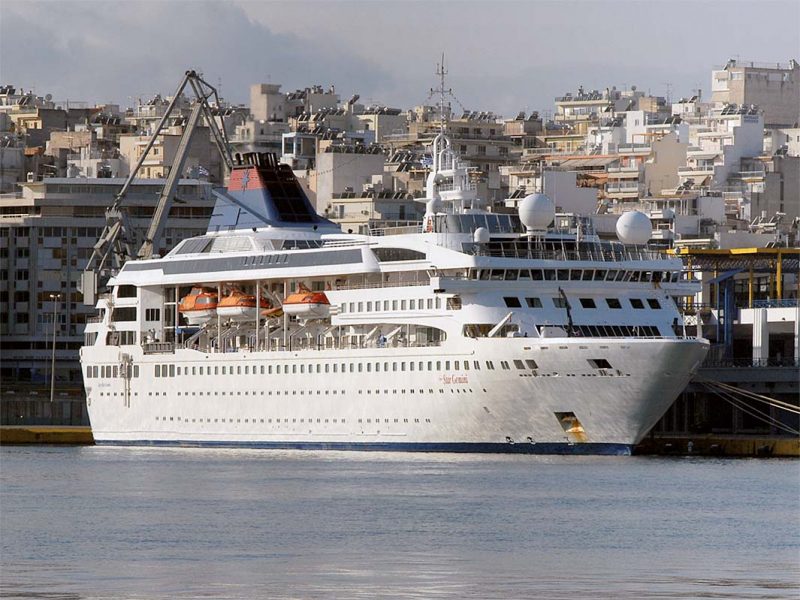
Langkawi And Phuket Islands
The company built a new cruise terminal in 1997 at Port Klang to the north of Selangor in Malaysia, and within very easy reach of Kuala Lumpur, the capital. Around 25 million tourists visit Kuala Lumpur and Malaysia each year particularly from Singapore, Indonesia, Thailand, Brunei, Japan and Thailand, and if only a small proportion took a short cruise to Langkawi island the route would be a success. A high speed aluminium alloy ferry powered by four jet propulsion units and having two stern doors for ro-ro traffic was purchased from P. & O. service on the Portsmouth to Cherbourg and Cairnryan to Larne routes as Superstar Express and was renamed Superstar Express Langkawi. She was built in 1997 at Fremantle by Austal Ships (Pty) Ltd., and connected the main island terminal of Star Cruises at Langkawi with the other islands in the archipelago and with the mainland. Cruise passengers coming ashore at Phuket usually visited the tourist ‘hotspots’ of Kata, Karon and Patong. Phuket island is off the short Thailand coastline on the Indian Ocean, with Thailand also having a much longer coastline on the Gulf of Thailand.
The aim of Star Cruises was to have ten cruise ships in service by the Millennium. This ambition was fulfilled with the purchase of four more ships in 1998 and the delivery of two new very large cruise ships from the Meyer yard at Papenburg in Germany. The purchased ships were renamed Superstar Capricorn (the former Royal Viking Sky), Superstar Sagittarius (the former Sun Viking), Superstar Aries (the former Europa of Hapag), and Superstar Taurus (the former Baltic ferry Sally Albatross). The purchase of Sun Viking from Royal Caribbean Cruise Lines (RCCL) was very interesting, as she was well known in South East Asian waters, having cruised during all of 1997 from Singapore, Hong Kong, Beijing and Bangkok on fifteen night cruises for RCCL. This was obviously a strategic purchase to remove a competing vessel from the market that Star Cruises was wishing to dominate.
The two large new cruise ships were Superstar Leo and Superstar Virgo of 75,338 grt, completed in September 1998 and August 1999 respectively by the Meyer yard at Papenburg in Germany. This yard is inland and requires new large cruise ships to make a slow passage down the river Ems to Emden covering two high tides. They have dimensions of 268.6 metres in length, 32.25 metres beam, and 11.5 metres draft, with a passenger capacity of 2,640 on a two per cabin basis. They are powered by four huge fourteen cylinder M.A.N. diesel engines of 79,944 bhp driving two controllable pitch propellers to give cruising speeds of 24 knots. These giant cruise ships were a step up in size in the fleet of Star Cruises and were designed for world cruising. Star Cruises also took over Sun Cruises during the same period. Superstar Capricorn and Superstar Sagittarius were part of a short lived joint cruise venture in 1998 with Hyundai of Korea, from which only Superstar Capricorn regained her name in 2001.
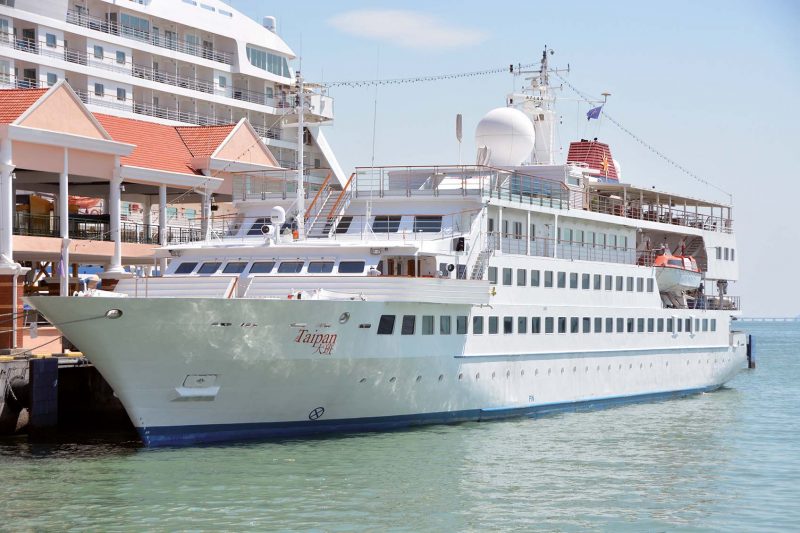
Takeover Of NCL Cruising Fleet
This big step in the development of a cruise fleet that was to occupy the third biggest slot in the worldwide cruise industry occurred in January 2000. On the eleventh day of the month, Colin Veitch joined the Board of Star Cruises PLC, with plans also to appoint him President and CEO of NCL as soon as the takeover procedures for NCL had been completed. Star Cruises purchased 50% of the shares of NCL Holdings on this date and made a mandatory offer for the balance of the shares a few days later. Colin Veitch was an experienced cruise industry professional as a Financial Officer, President and Marketing Development Officer for Princess Cruises in California and P. & O. (Australia) Pty Ltd.
Dato K.T. Lim, Chairman of Star Cruises, welcomed Mr. Veitch to the Board of Star Cruises, and valued his deep knowledge of the American, European and Australian cruise market. Star Cruises now had a fleet of eighteen cruise ships with over 22,000 lower cruise berths, a figure that does not normally include the ultra luxury staterooms on the top decks of cruise ships. Five more large cruise ships were on order to give a big fleet of 23 cruise ships by 2004. The South East Asia home ports of Star Cruises at Singapore, Port Klang, Hong Kong, Taipei, Bangkok, Phuket, Kobe and Osaka were now joined by the worldwide home ports of NCL including those for Caribbean, Alaskan, Bermudan, European and South Pacific cruises. Orient Lines, with two cruise ships, and Norwegian Capricorn Line with one cruise ship operating Australian based cruises to the South Pacific, came to Star Cruises as part of the NCL takeover.
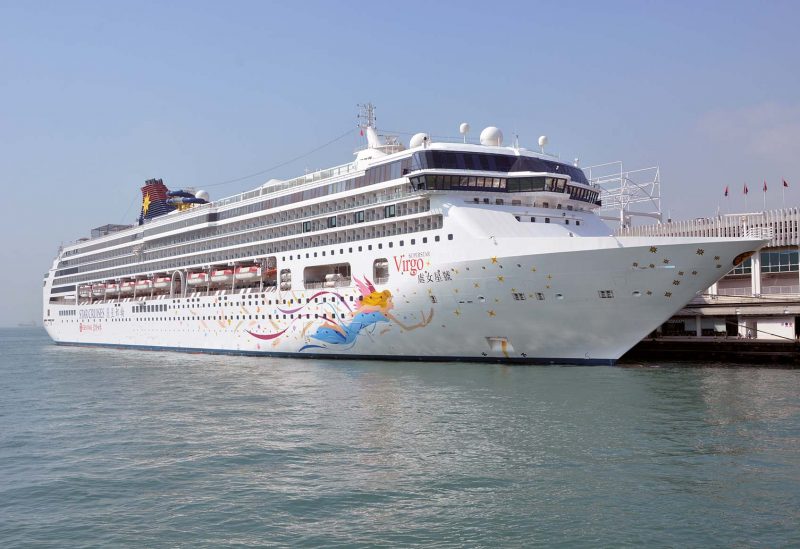
The history of NCL is important here, as they were one of the five pioneers of the modern cruise industry in 1966. NCL originated in Norway in the Kloster family of Bygdoy in Oslo, and they were trading half a dozen tankers of 20,000 dwt profitably in 1965 under Kloster’s Rederi A/S. Knut Utstein Kloster then placed an order for an 11,000 grt cruise ship with the Bergens A/S shipyard, which was completed as Sunward in 1966 and initially ran from Southampton to the Mediterranean for a short while after completion. NCL was then formed by the Kloster family with Ted Arison, a resident of Miami, as the Marketing Manager for Miami based cruises. Sunward, complete with a large yellow sun on both sides of her hull, was thus the important pioneer of many smart, new, fun-filled Caribbean cruise ships.
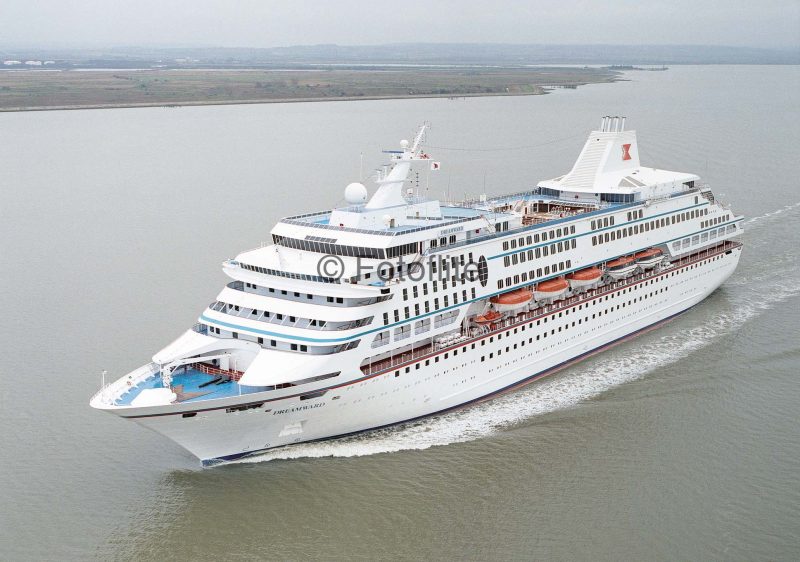
Sunward was quickly followed by Starward of 1968, Skyward of 1969, and Southward of 1971, the first pair from the A.G. Weser yard in Germany and the third from the Riva Trigoso yard in Italy. The similar Cunard Adventurer with a heavily raked funnel was purchased in 1977 and renamed Sunward II. This quartet formed the basis of the NCL fleet until the early 1990s, having been joined in 1980 by the classic converted French Line Transatlantic liner France renamed as Norway. This beautiful and much loved liner lost half of her horsepower to make her economic enough to run to the Caribbean, but gained two large tenders on her fo’c’stle for landing passengers on the NCL private island in the Bahamas.
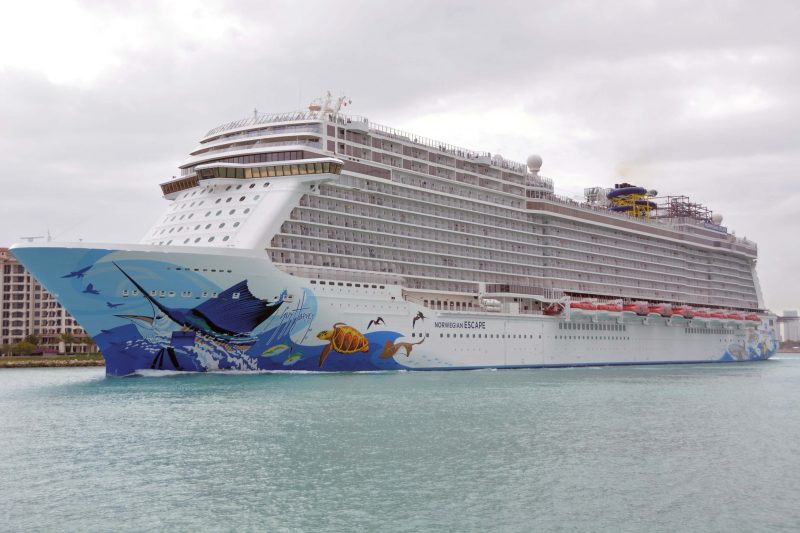
The purchase of the upmarket Royal Viking Line in 1984 to the Balance Sheet of NCL was an important step, but the budget NCL fleet was kept quite separate from the Royal Viking Line trio of luxury cruise ships. The latter trio made long, luxurious cruises and were headquartered in San Francisco, while the budget conscious NCL fleet cruised out of Miami. The only indication of amalgamation of these two distinct fleets was the transfer of crew members across America. In 1987, the company name was changed to Norwegian Cruise Line from Norwegian Caribbean Line to more accurately reflect the business nature of the company, which retained the useful NCL logo. The five star luxury new cruise liner Royal Viking Sun of 37,845 grt joined the Kloster fleets in 1988 from the Wartsila yard in Helsinki, and Seaward of 42,276 grt also from Wartsila during the same year.
In 1990, there were three distinct NCL cruising fleets, budget conscious NCL in Miami, luxury Royal Viking Line making worldwide cruises, and Royal Cruise Line with the cruise ships Royal Odyssey (ex Shalom) and Crown Odyssey of 34,242 grt built in 1988. Royal Cruise Line was purchased from the Panagopoulos family of Greece in 1990, and transfers between these three NCL fleets then started to occur with two of the Royal Viking trio renamed as Star Odyssey and Royal Odyssey. The third cruise ship of this trio was renamed Sunward in 1991 after the sale of Sunward II to Epirotiki Line of Greece. Dreamward and Windward, sisters of 39,217 grt delivered in 1992/93 by the St. Nazaire yard of Chantiers de l’Atlantique, overstretched the finances of the Kloster family and huge debts of nearly one billion dollars had built up by 1995. The Royal Viking Line trio was sold to Trafalgar House of London, and with the support of the American banks and the purchase of huge blocks of shares by Carnival Lines, the bankruptcy of NCL was avoided.
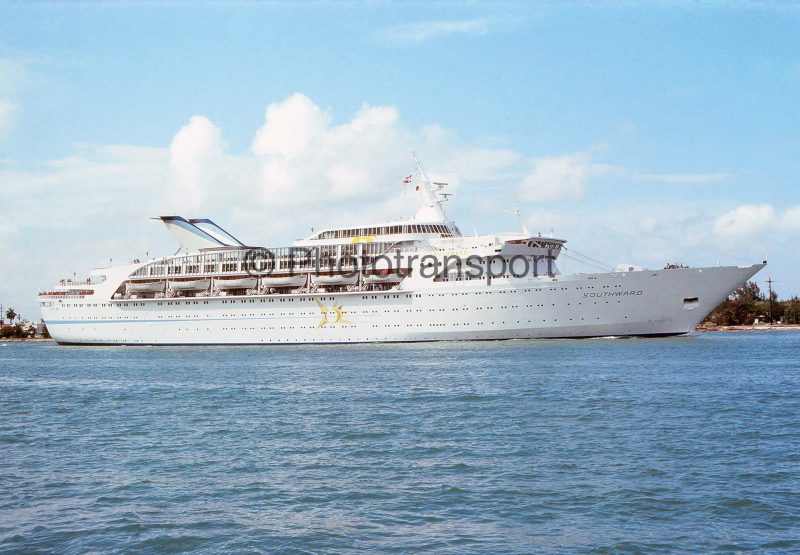
The Silja Line ferry Sally Albatross was converted into a cruise ship for $60 million and chartered for four years as Leeward from the end of 1995, cruising with her consorts Norway, Seaward, Dreamward, Windward and Norwegian Crown, the former Crown Odyssey renamed in early 1996 for cruising out of Dover. Dreamward and Windward were lengthened at the end of 1997 at the Lloyd Werft yard in Germany to create five hundred extra cruising berths on each vessel. The 1997 NCL cruising programme was as follows:-
- Seaward on seven and fourteen day cruises out of San Juan in Puerto Rico or Santo Domingo in the Dominican Republic on either Barbados or Aruba itineraries.
- Windward on winter Caribbean and summer Alaskan cruises.
- Dreamward on summer Bermudan cruises, and autumn New England and Canadian cruises, followed by winter Caribbean cruises.
- Norwegian Crown on summer Scandinavian, Baltic and Mediterranean cruises out of Dover, and winter Caribbean cruises out of Fort Lauderdale.
- Norway on year round seven day and fourteen day Western and Eastern Caribbean cruises out of Miami to St. Thomas, St. John, St. Maarten, Grand Cayman, Ocho Rios in Jamaica, Cozumel, Cancun and Playa del Carmen in Mexico.
- Leeward on year round three and four day cruises to the Bahamas and Mexico out of Miami.

Two German built big new similar cruise ships of 77,000 grt joined NCL in 1999 and 2001 in Norwegian Sky and Norwegian Sun with accommodation for 2,480 passengers on a two per cabin occupancy basis. The former had been launched as a bare hull as Costa Olympia for Costa Lines by the Bremer Vulkan Werft yard, and was then purchased by NCL and completed in dry dock by Lloyd Werft Gmbh, Bremerhaven. The latter cruise ship had the same dimensions of length 258.6 metres, beam of 32.25 metres and draft of 14.1 metres but had been launched by the Aker Werft yard at Wismar and completed in dry dock by Lloyd Werft Gmbh, Bremerhaven. They were powered by identical engines, comprising three six cylinder and three seven cylinder M.A.N. engines of 67,000 bhp driving two controllable pitch propellers at a cruising speed of 20 knots. Dreamward, Seaward and Windward had by then been renamed as Norwegian Dream, Norwegian Sea and Norwegian Wind, while Norwegian Majesty of comparable size to this trio was the former Royal Majesty built in 1992 for Majesty Cruise Line.
NCL Holdings became a publicly listed company on the New York Stock Exchange in 1999, but delisted following acquisition by Star Cruises in January 2000. The ‘Freestyle Concept’ of cruising was immediately introduced into both the NCL and Star Cruises fleets. This concept provided more flexible dining, including a wider choice of restaurants with no fixed dining times or pre-assigned seating, while dropping formal dining attire requirements in favour of more relaxed and casual dress. This was a real innovation in the cruising industry, and was attractive to the many new first time cruisers, of whom the men did not wish to wear formal suits and the ladies did not wish to wear party dresses to dine out.

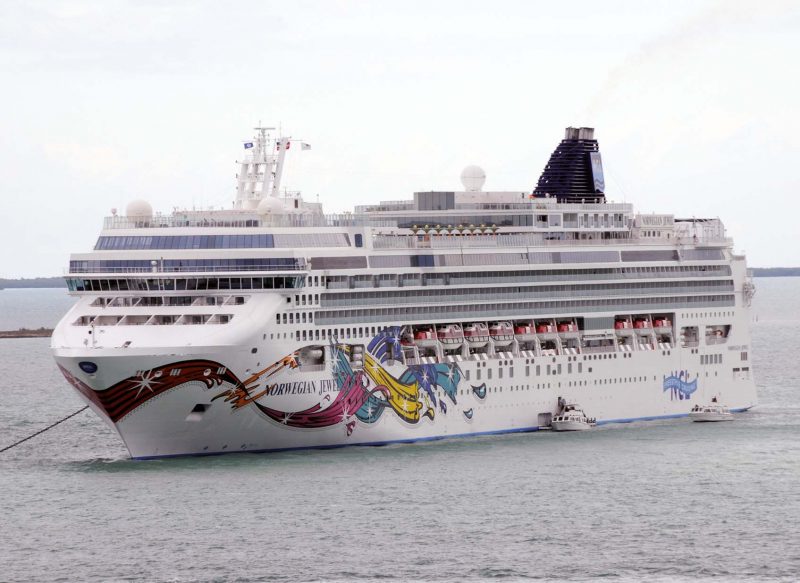
Werft at Papenburg.
New ‘Freestyle’ Large Cruise Ships
Six large new cruise ships of 93,250 grt were completed to the order of Star Cruises for operation under the NCL banner, while the older and smaller cruise ships tended to be transferred from NCL for operation under the Star Cruises banner. The same yard that had built Superstar Leo and Superstar Virgo in 1998/99 was entrusted with this very big and expensive building programme, the Meyer yard at Papenburg. Norwegian Star was first to arrive in October 2001, then Norwegian Dawn in December 2002, Norwegian Jewel in August 2005, Pride of Hawaii in June 2006 for the associated NCL America subsidiary for cruising out of Hawaii, Norwegian Pearl in November 2006, and finally Norwegian Gem in October, 2007. The similar Superstar Leo was transferred from Star Cruises to NCL in 2004 and renamed Norwegian Spirit.
This big new sextet had dimensions of length 294.1 metres, beam of 32.25 metres and draft of 11.5 metres and had accommodation for two thousand five hundred passengers on a two per cabin occupancy basis. They had high cruising speeds of 24.7 knots from four fourteen cylinder four stroke M.A.N. Vee diesel engines of 80,000 bhp driving four generators connected to two electric motors and driving two Azipods. As well as appealing to new first time cruisers as ‘Freestyle’ ships with a much more relaxed dining and attire agenda, this sextet introduced new bold ‘hull arts’ along the full length of both sides of their hulls. This took several forms in yellow, red, green and blue swirls of colour and included depictions of swimmers and other sports enthusiasts enjoying the many such facilities to be found on board. I have seen ‘hull arts’ on both NCL and Aida of Germany cruise ships at several ports, and while I think that they are very attractive to the eye, to the cruise ship purist they certainly detract from the clean design sweep of their extremely long hulls.
Star Cruises also received ‘hull arts’ to their big fleet of cruise ships in 2011, starting with Superstar Virgo of 1999, Superstar Aquarius (the former Windward and Norwegian Wind), and Star Pisces of 1990. The former Seaward and Norwegian Sea had joined Star Cruises in 2005 as Superstar Libra, and it was announced by Star Cruises on 27th April 2012 that Norwegian Dream, the former Dreamward, would join the Star Cruises fleet as Superstar Gemini and begin service at the beginning of 2012. The first Superstar Gemini had been sold in 2008 and renamed Vision Star and then Gemini and was then laid up for some years.
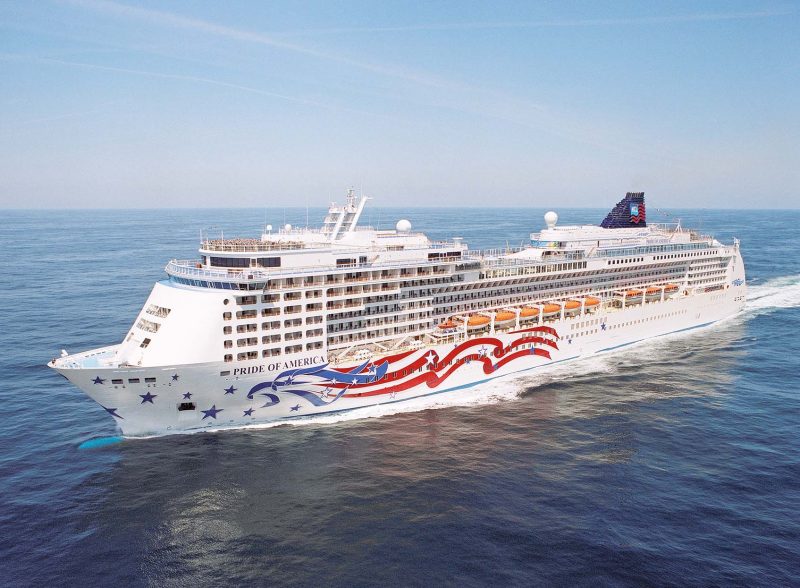
with the Jones Act, although she was finished by Lloyd Werft at Bremerhaven.
The NCL America brand was launched in 2004 with cruise ships sailing under the American flag for the first time in fifty years, and the first to provide inter island cruises at Hawaii. Superstar Leo was transferred to NCL in 2004 as Norwegian Spirit and took over the cruise schedule of Norwegian Sky. The latter vessel had been rushed into service that year under the NCL America banner as Pride of Aloha for Hawaii cruising due to the cruise ship Pride of America not being ready on time at the Lloyd Werft yard. The hull of Pride of America had been built by the Ingalls Shipbuilding Division at Pascagoula in Mississippi State, and then towed to Bremerhaven for completion. She has seven continuous decks and seven non continuous decks, two thrusters forward and two thrusters aft. She is powered by six eight cylinder four stroke Wartsila diesel engines of 68,526 bhp connected to two electric motors driving two Azimuth electric drive units to give a cruising speed of 21 knots.
In early 2008, both the NCL America and Orient Lines brands were discontinued, with Norwegian Sky regaining her original name, and Pride of Hawaii built in 2006 renamed as Norwegian Jade. Marco Polo, the former elegant Russian cruise ship Aleksandr Pushkin built in 1965, was sold off to Greek interests as the last ship of Orient Lines. Pride of America also retained her name for American cruising with the NCL brand.
In June 2010, NCL welcomed a new giant cruise ship into their fleet in Norwegian Epic of 155,873 grt with accommodation for 4,200 passengers based on a two per cabin occupancy. She was completed by the St. Nazaire yard of STX France S.A. on dimensions of length 330 metres, beam of 40.2 metres, and draft of 21.6 metres. She was powered by six giant MaK diesel engines of 109,320 bhp driving three generators connected to two electric motors and two Azipods to give a cruising speed of 22.5 knots. She has five continuous decks and fourteen non continuous decks, four thrusters forward and two thrusters aft.
Norwegian Epic has 24 restaurants, snack bars, buffet and bistro eating places, 13 accommodation grades including one for single passengers, 20 bars and lounges, cinema, theatre and other public rooms. Asian, French, Italian, Spanish tapas, Portuguese and Brazilian churrascaria, Japanese teppanyaki, Steakhouse, Seafood, Sushi, Pizza and many other types of international cuisine are available. Norwegian Epic also introduced on decks 16 and 17 the concept of ‘The Haven’ of 45 exclusive luxury suites forward and above the navigating bridge. This enclave forms a ‘ship within a ship’ if one is prepared to pay a much higher tariff for luxury and privacy. Luxury Suites comprise large bedrooms with king size beds, separate living room, dining room and toilet facilities, with Garden Villas, Family Villas, Courtyard Penthouses, and Deluxe Spa Suites also available within ‘The Haven’. Private key card access, concierge personal service, and 24 hour butler service are standard within the tranquillity and privacy of ‘The Haven’.
A further fifteen big cruise ships were in the NCL and Star Cruises fleets in 2010 as Norwegian Dawn, Norwegian Dream, Norwegian Gem, Norwegian Jade, Norwegian Jewel, Norwegian Pearl, Norwegian Sky, Norwegian Spirit, Norwegian Star, Norwegian Sun, Pride of America, Star Pisces, Superstar Aquarius, Superstar Libra and Superstar Virgo. Norwegian Majesty had been sold in 2009 to Louis Cruises of Cyprus and renamed Louis Majesty.
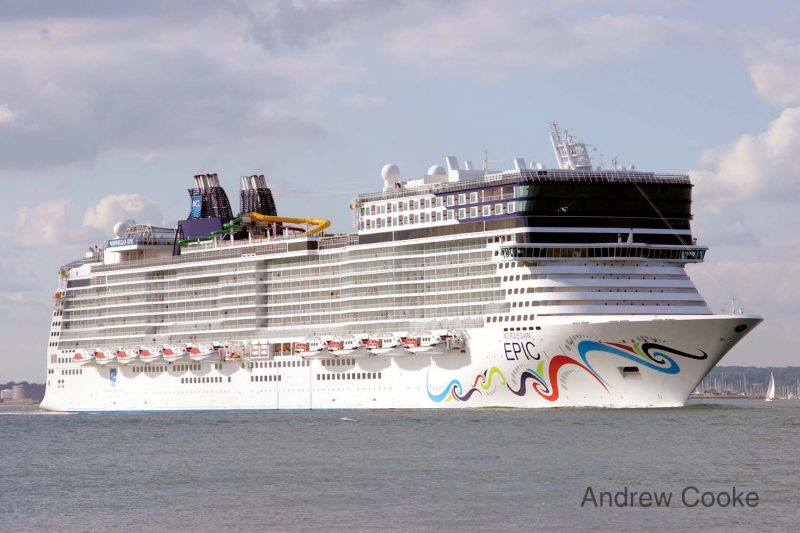
Photo: Andrew Cooke
Epic, Escape, Getaway And Breakaway
Star Cruises and NCL had hugely benefitted from their ‘Freestyle Cruising’ concept with turnover in 2012 at over two billion dollars. Three giant similar vessels to Norwegian Epic came into service during the years 2013 to 2015 as Norwegian Escape and almost identical to Norwegian Epic, and the slightly ‘trimmed down in size’ Norwegian Getaway and Norwegian Breakaway, all from the Meyer yard at Papenburg. They have accommodation for 4,028 passengers on a two per cabin occupancy basis, and two similar cruise ships were ordered on 7th October 2013 and 10th February 2014 from the same yard for operation under Star Cruises. This last new pair will be delivered in the Autumn of 2016 and the Autumn of 2017. All four new NCL giant cruise ships and the two under construction for Star Cruises feature prominently ‘The Haven’ concept of around fifty high luxury private suites in a ‘ship within a ship’ above the navigating bridge. The ‘hull arts’ of this giant sextet, each of around 150,000 grt to 160,000 grt with hull lengths of 330 metres will eclipse any previous ‘hull arts’ seen in the NCL and Star Cruises fleets.
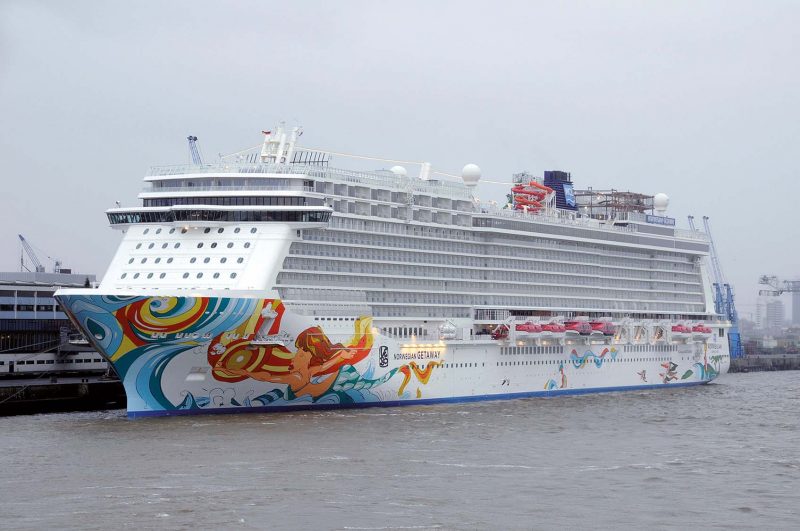
These six giant new cruise ships will provide mass cruising worldwide for the Genting Group fleets of Star Cruises and NCL and bring the total of their cruise ships up to twenty two ships with cruise berths for over 50,000 passengers. The following cruises are available in the Far East portfolio of Star Cruises from their own terminal in Port Klang, and Hong Kong (Ocean Terminal) and Singapore (Harbourfront Centre):-
- MALAYSIA Cruise from Port Klang to Langkawi Island, Malacca, Penang, Redang Island, as well as Krabi and Phuket on the Andaman Sea coastline of Thailand.
- THAILAND Cruise in the Gulf of Thailand to the port of Laem Chabang, the gateway port to Bangkok, and the fabulous island of Ko Samui in the Gulf of Thailand.
- CHINA Cruise to Sanya in the South China Sea, and to vibrant Hong Kong to give a taste of this bustling country.
- JAPAN The Yaeyama Islands have stunning natural beauty, pearl fishing and white sand beaches. Okinawa and its capital of Naha have a diversity of Japanese cuisine to sample.
- TAIWAN The port of Hualien has mountain ranges dropping down to fringe this city on its eastern coastline, and also cruise to the fabulous Matsu Islands.
- INDONESIA Cruise to the many islands of this fabulous country, or to the independent state of Brunei on the north coast of Borneo, as well as Sabah and Sarawak on Borneo and part of Malaysia. Takeover Of Prestige Cruises
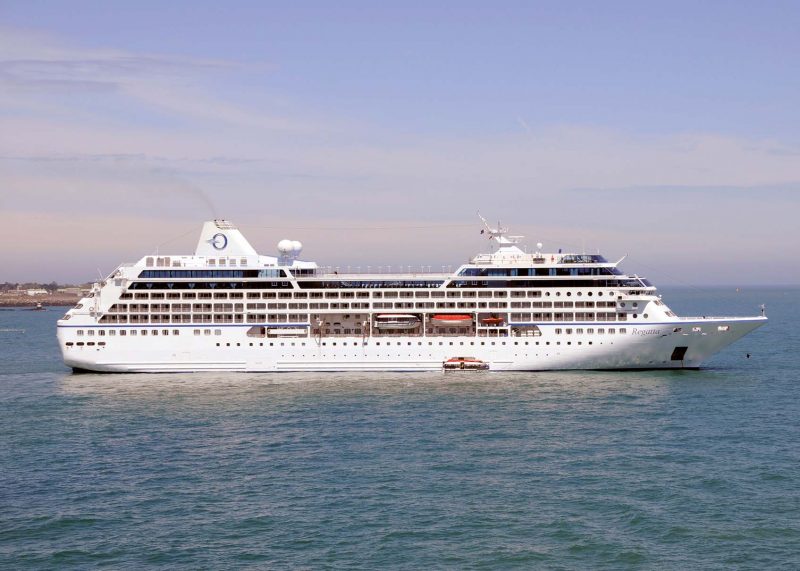
On 2nd September 2014, Star Cruises took over Prestige Cruises with a fleet of eight cruise ships jointly under Regent Seven Seas Cruises and Oceania Cruises for $3.025 billion including debt. These two cruise lines are market leaders in the ‘upscale’ cruise sector and offer all inclusive six star cruising. An extra amount of up to $50 million will be paid to Prestige Cruises shareholders dependent on certain performance targets being met by the end of 2015. NCL financed the takeover with existing cash, new and existing debt, and 20.3 million new shares.
The takeover included the 738 berth newbuilding which was delivered from Fincantieri in Italy in 2016, the Seven Seas Explorer of 55,254 grt. The Regent Seven Seas fleet is Seven Seas Voyager, Seven Seas Mariner and Seven Seas Navigator completed between 1999 and 2003 and cruising worldwide.
Regent Seven Seas Cruises was formerly known as Radisson Seven Seas Cruises of Miami and founded in 1990. The unique ‘Swath’ type cruise ship Radisson Diamond of 20,295 grt was completed in 1992 by Finnyards O/y at Rauma with accommodation for 354 passengers. She sailed for Radisson until 2005 when she was sold and began sailing in Far East waters as the casino cruise ship Asia Star.
Radisson Seven Seas Cruises later became Regent Seven Seas Cruises and was purchased by the investment group Apollo Management of New York for $1 billion in February 2008, to include the three cruise ships Seven Seas Mariner, Seven Seas Navigator and Seven Seas Voyager.
Apollo Management also owned Oceania Cruises, founded in 2002 by cruise industry veterans Joe Watters and Frank del Rio, the former Vice President of Renaissance Cruises. Renaissance had been founded in 1989 by Fearnley & Eger of Oslo, with a history dating back to 1869 but which was already in financial trouble at the time and went into voluntary liquidation in March 1991.
Renaissance Cruises is remembered for its building of two octets of sister cruise ships, the first having accommodation for 114 passengers and were constructed in Italian yards between 1989 and 1992. They were sold off to the Italian controlled Carmeli Group with other finance coming from Norwegian and American sources.
Their nomenclature was simple with only the addition of a number between one and eight as a suffix to ‘Renaissance’. The second octet of sister cruise ships were completed by Chantiers de l’Atlantique at St. Nazaire between 1998 and 2002 and had accommodation for 702 passengers with an even simpler nomenclature of ‘R’ followed by the spelling of the numerals one to eight.
Unfortunately, Renaissance Cruises was declared bankrupt in 2002 and the latter octet of cruise ships was laid up at Gibraltar.
Oceania Cruises chartered R Two in October 2002 from Cruiseinvest and renamed her Insignia, but in June 2003 Insignia was renamed Regatta and sister R One was chartered from Cruiseinvest and renamed as the new Insignia.
A third sister was chartered in November 2005 from Cruiseinvest as R Five and renamed Nautica, and in June 2007 contracts were placed for two new cruise ships, Marina and Riviera, with Fincantieri for completion in 2011 and 2012.
The majority of the shares of Oceania Cruises were sold in February 2007 to Apollo Management of New York, who shortly afterwards purchased Regent Seven Seas Cruises. The latter cruise line, in contrast to other cruise lines, offers worldwide cruising on an ‘all inclusive’ basis covering alcoholic beverages onboard, most shore excursions, gratuities to cruise ship staff, airfare to and from the cruise’s origin and destination ports, as well as one free hotel night prior to boarding.

Postscript
Star Cruises is rightly credited with introducing and developing cruise and casino ships in the Asia Pacific region. However, now that their worldwide cruising portfolio encompasses the massive and mature American, European and Australian and worldwide cruise markets, and attracts a very big following for their ‘Freestyle’ type of informal cruising, it is a signal to Carnival Cruises and Royal Caribbean International that their reigns as the biggest cruise fleets in the world may be over.

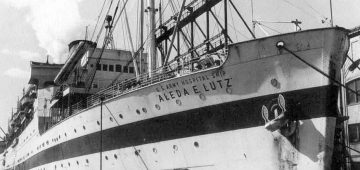
Comments
Sorry, comments are closed for this item